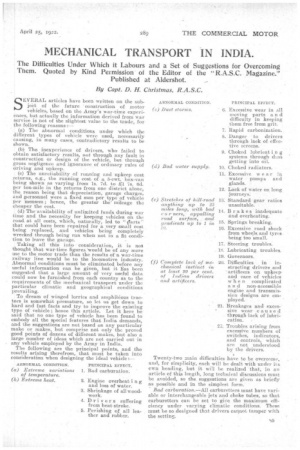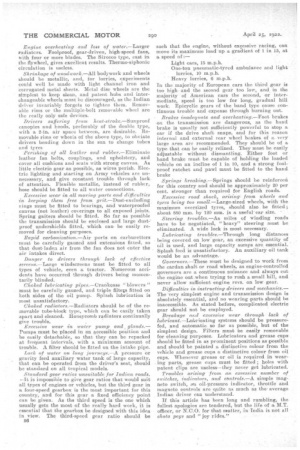MECHANICAL TRANSPORT IN INDIA.
Page 9

Page 10

If you've noticed an error in this article please click here to report it so we can fix it.
The Difficulties Under Which it Labours and a Set of Suggestions for Overcoming Them. Quoted by Kind Permission of the Editor of the " R.A.S.C. Magazine." Published at Aldershot.
By Capt. D. H. Christmas, R.A.S.C.
SEVERAL EVERAL articles have been written on the sub
jut of the future ' construction of motor
SEVERAL EVERAL articles have been written on the sub
jut of the future ' construction of motor vehicles, based on the Army's war-time experiences, but actually the information derived from war service is not of the slightest value to the trade, for the following reasons:— .
(a.) The abnormal conditions under which the different types of vehicle were used, necessarily causing, in many cases, contradictory results to be shown.
(b) The inexperience of drivers, who failed to obtain satisfactory results, not through any fault in construction or design of the vehicle, but through gross negligence and ignorance of ordinary rules of driving and upkeep.
(c) The unreliability of running and upkeep cost returns e.g., the running cost of a 5-cwt. box-van being shown as varying from Is. 7d. to RI is. ed. per ton-mile in the returns from one district alone, the reason being that depreciation, garage charges, and personnel were a fixed sum per type of vehicle per mensem ; hence, the greater the' mileage the cheaper the cost.
(d) The availabilityof unlimited funds during war time and the necessity for keeping vehicles on tin road. at all costs, which, naturally, led to "tarts '. that could have been repaired for a very small cost being replaced, and vehicles being completely wrecked through being run when not in a fit condition to leave the garage.
Taking all this into consideration, it is not thought that war-time figures 'would be of any more use to the motor trade than the results of a war-time railway line would be to the locomotive industry. Abnormal conditions must be eliminated before any useful information can be given, but it has been suggested that a large amount of very useful data could now be furnished from each country as to the requirements of the mechanical transport under the particular climatic and geographical conditions prevailing. .
To dream of winged lorries and amphibious tractors is somewhat premature, so let us get down to hard and fast facts and try to improve the existing type of vehicle ; hence this article. Let it here be said that no one type of vehicle has been found to embody all the special features that India demands, and the suggestions are not based on any particular make or makes, but comprise not only the proved -good points of dozens of different makes, but also a large number of ideas which are not carried out in any vehicle employed by the Army in India.
The following are the principal points, and the results arising therefrom,. that must be taken into consideration when designing the ideal vehicle:—
ABNORMAL CONDITION. PRINCIPAL EFFECT.
(a) Extreme variations 1. Bad carburation. ' of temperature.
(b) Extreme heat. 2. Engine overheat i n g and loss of water.
3. Shrinkage of all woodwork.
4. Drivers suffering from heat-stroke.
5. Perishing of all leather and rubber.
PRINCIPAL EFFECT.
" 6. Excessive wear in all moving parts and difficulty in keeping :them free from grit.
7. Rapid carbonization.
8. Danger to drivers through lack of effective screens.
9. Choked lubricat i n g systems through dust getting into oil.
10. Choked radiators.
11. Excessive wear in water pumps and glands.
12. Lack of water on long journeys.
13: Standard gear ratios unsuitable.
14. Brakes inadequate and overheating.
15. Springs breaking.
16. Excessive road shock from wheels, and tyres being too email.
Steering troubles. Lubricating troubles. Governors. 17.
Difficulties in in structing drivers and artificers on upkeep and care of vehicles when complicated a n d non-accessible engine and transmission designs are employed.
21. Breakages and excessive wear caused through lack of lubrication.
22. Troubles arising from excessive numbers of switches, indicators, and controls, which are not understood by the drivers.
Twenty-two main .difficulties bare to he overcome, and, for simplicity, each will be. dealt with under its own heading, but it will be realized that, in an article of this length, long technical discussions must be avoided, so the suggestions are given as briefly as possible and in the simplest form.
Bad carburation.—All carbtretters must have variable or interchangeable jetsand choke tubes; so that carburetters can be set to give the maximum efficiency under varying climatic:. conditions. These must be so designed that drivers caimot tamper with the setting. Engine overheating and loss of water.—Larger radiaters. Foolproof, gear-driven, high-speed fans, with four or more blades. The Sirocco type, cast in the flywheel, gives excellent results. Thermo-siphonic circulation is useless.
Shrinkage of wood work.—All bodywork and wheels should be metallic, and, for lorries, experiments could well be made with light channel iron and 'corrugated metal sheets. Metal disc wheels are the simplest to keep clean, and patent hubs and interchangeable wheels must be discouraged, as the Indian driver invariably forgets to tighten them. Removable rims or the multiple-bolt removable wheel are the really only safe devibes.
Drivers suffering from heat-stroke.—Sunproof canopies and hoods, preferably of the double type, with a 2-in, air space between, are desirable. Removable rims or wheels of the above type, to obviate drivers bending down in the sun to change tubes and tyres Perishing of all leather and rubber.—Eliminate leather fan belts, couplings, and upholstery, and coverall cushions and scats with strong canvas. As little electric gear as possible, as wires perish. Electric lighting and starting on Army vehicles are unnecessary, and give constant trouble through lack of attention. Flexible metallic, iustead of rubber, hose should be fitted to all water connections.
Excessive wear in all moving parts and difficulties in, keeping them free from grit.—Dust-excluding rings must be fitted to bearings, and waterproofed canvas (not leather) coverings to all exposed joints. Spring gaiters should be fitted. So far as possible the transmission should be enclosed and large dustproof undershields fitted, which can be easily removed for cleaning purposes.
Rapid carbonization.—Air ports on carburetters must be carefully gatized and extensions fitted. so that dust-laden air from the fan does not enter the air intakes direct.
Danger to drivers through lack of effective screens.—Large windscreens must be fitted to all types of vehicle, even a:tractor. Numerous accidents have occurred through drivers being momentarily blinded.
Choked lubricating pipes.—Crankcase "blowers " must be carefully gauzed, and triple filtees fitted on Loth sides of the oil pump. Splash lubrication is most unsatisfactory.
Choked radiators.--Radiators should be of the removable tube-block type, which can be easily taken apart and cleaned. Honeycomb radiators continually give trouble.
Excessive wear in water pump and glands.— Pumps must be placed in an aocessible position and be easily -detachable, so that they can be repacked at frequent intervals, with a minimum amount of trouble. A filter should be fitted on the intake pipe.
hack of water on long journeys.—A pressure or gravity feed auxiliary water tank of large capacity, that can be operated from the driver's seat, should be standard on all tropical models.
Standard gear ratios unsuitable for Indian roads. —It is impossible to give gear ratios that would suit all types of engines or vehicles, but the third gear in a four-speed gearbox is the most important for this country, and for this gear a fixed efficiency point can be given. As the third speed is the one which usually gets the most of the really hard work, it is essential that the gearbox be designed with this idea in view. The third-speed gear ratio should be B6 auch that the engine, without excessive racing, can move its maximum load up a gradient of 1 in 15, at a speed of :— Light cars, 15 m.p.h.
One-ton pneumatie-tyred ambulance and light lorries, 10 m.p.h.
Heavy lorries, 6 m.p.h.
In the majority of European cars the third gear is too high. and the second gear too low, and in the majority of American cars the second, or intermediate, speed is too low for long, gradual hill work. Epicyclic gears of the band type cause continuous trouble and expense through burning out.
Brakes inadequate and overheating.—Foot brakes on the transmission are dangerous, as the hand brake is usually not sufficiently powerful to stop a car if the drive shaft snaps, and for this reason internal and external rear wheel brakes of a very large area are recommended. They should be of a type that can be easily relined. They must be easily adjustable without dismantling. Either foot or band brake must be capable of holding the loaded vehicle on an incline of 1 in 10, and a strong foolproof ratchet and pawl must be fitted to the hand brake Springs breaking.—Springs should be reinforced for this country and should be approximately 20 per cent. stronger than required for English roads.
Excessive road shock, arising. from wheels and tyres being too small.—Large-sized wheels, with the maximum oversized tyres, should also. be fitted; about 880 mm. by 120 mm. is a useful car size.
Steering troubles.—As miles of winding roads have to be negotiated, "heavy" steering must be eliminated. A wide lock is most necessary.
Lubricating troubles.—Through . long distances being covered on low-gear, an excessive quantity of oil is used, and large capacity sumps are essential. Splash feed is unsatisfactory. An auxiliary oil tank would be an advantage.• Governors.—These must be designed to work from the cardan shaft or road wheels, as engine-controlled governors are a continuous nuisance and always cut the engine out when trying to rush a small hill, and never allow sufficient engine, revs. on low gear.
Difficulties in instructing drivers and mechanics.— The very simplest engine and transmission design is absolutely essential, and no wearing parts should be inaccessible. As stated before, complicated electric gear should not be employed.
Breakage and excessive wear through lack of lubricant.--Lubricating systems should be pressurefed, and automatic so far as possible, but of the simplest design. Filters must be easily removable for cleaning purposes. Lubricators and grease cups should be fitted in as prominent positions as possible and should be painted a distinctive colour from the vehicle and grease cups a distinctive colour from oil cups. Whenever grease or oil is required in wear. ing parts, grease cups must be fitted; holes with patent clips are useless—they never get lubricated.
Troubles arising from an excessive number of switches, indicators, and controls.—A simple magneto switch, an oil-pressure indicator, throttle and magneto controls are quite as much as the average Indian driver can understand.
If this article has been long and rambling, the fullest apologies are tendered, but the life of a M.T. officer, or N.C.O. for that matter, in India is not all chota pegs and "joy rides."






























